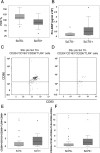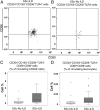A circulating cell population showing both M1 and M2 monocyte/macrophage surface markers characterizes systemic sclerosis patients with lung involvement
- PMID: 30249259
- PMCID: PMC6154930
- DOI: 10.1186/s12931-018-0891-z
A circulating cell population showing both M1 and M2 monocyte/macrophage surface markers characterizes systemic sclerosis patients with lung involvement
Abstract
Background: Systemic sclerosis (SSc) is a disorder characterized by immune system alterations, vasculopathy and fibrosis. SSc-related interstitial lung disease (ILD) represents a common and early complication, being the leading cause of mortality. Monocytes/macrophages seem to have a key role in SSc-related ILD. Interestingly, the classically (M1) and alternatively (M2) activated monocyte/macrophage phenotype categorization is currently under revision. Our aim was to evaluate if circulating monocyte/macrophage phenotype could be used as biomarker for lung involvement in SSc. To this purpose we developed a wide phenotype characterization of circulating monocyte/macrophage subsets in SSc patients and we evaluated possible relations with lung involvement parameter values.
Methods: A single centre cross-sectional study was performed in fifty-five consecutive SSc patients, during the year 2017. All clinical and instrumental tests requested for SSc follow up and in particular, lung computed tomography (CT) scan, pulmonary function tests (PFTs), Doppler echocardiography with systolic pulmonary artery pressure (sPAP) measurement, blood pro-hormone of brain natriuretic peptide (pro-BNP) evaluation, were performed in each patient in a maximum one-month period. Flow cytometry characterization of circulating cells belonging to the monocyte/macrophage lineage was performed using specific M1 (CD80, CD86, TLR2 and TLR4) and M2 surface markers (CD204, CD163 and CD206). Non-parametric tests were used for statistical analysis.
Results: A higher percentage of circulating CD204+CD163+CD206+TLR4+CD80+CD86+ and CD14+CD206+CD163+CD204+TLR4+CD80+CD86+ mixed M1/M2 monocyte/macrophage subsets, was identified to characterize patients affected by SSc-related ILD and higher systolic pulmonary artery pressure. Mixed M1/M2 monocyte/macrophage subset showed higher percentages in patients positive for anti-topoisomerase antibody, a known lung involvement predictor.
Conclusions: The present study shows for the first time, through a wide flow cytometry surface marker analysis, that higher circulating mixed M1/M2 monocyte/macrophage cell percentages are associated with ILD, sPAP and anti-topoisomerase antibody positivity in SSc, opening the path for research on their possible role as pathogenic or biomarker elements for SSc lung involvement.
Keywords: Anti-topoisomerase antibody; Flow cytometry; Innate immunity; Interstitial lung disease; Lung CT scan; M1; M2; Monocyte/macrophage phenotype; Pulmonary artery hypertension; Pulmonary function tests; Systemic sclerosis.
Conflict of interest statement
Ethics approval and consent to participate
The study was approved by the Ethics Commitee of Polyclinic San Martino Hospital, Genoa, Italy (protocol number: 273-reg-2015). All patients gave a written informed consent before enrollment.
Consent for publication
Not applicable.
Competing interests
The authors declare that they have no competing interests.
Publisher’s Note
Springer Nature remains neutral with regard to jurisdictional claims in published maps and institutional affiliations.
Figures



Similar articles
-
Prevalence of hybrid TLR4+M2 monocytes/macrophages in peripheral blood and lung of systemic sclerosis patients with interstitial lung disease.Front Immunol. 2024 Nov 20;15:1488867. doi: 10.3389/fimmu.2024.1488867. eCollection 2024. Front Immunol. 2024. PMID: 39635531 Free PMC article.
-
Peripheral cells from patients with systemic sclerosis disease co-expressing M1 and M2 monocyte/macrophage surface markers: Relation to the degree of skin involvement.Hum Immunol. 2021 Sep;82(9):634-639. doi: 10.1016/j.humimm.2021.03.009. Epub 2021 May 19. Hum Immunol. 2021. PMID: 34020830
-
Nintedanib downregulates the profibrotic M2 phenotype in cultured monocyte-derived macrophages obtained from systemic sclerosis patients affected by interstitial lung disease.Arthritis Res Ther. 2024 Mar 20;26(1):74. doi: 10.1186/s13075-024-03308-7. Arthritis Res Ther. 2024. PMID: 38509595 Free PMC article.
-
Serum concentration of surfactant protein D in patients with systemic sclerosis: The potential marker of the interstitial lung disease severity.Best Pract Res Clin Rheumatol. 2018 Aug;32(4):541-549. doi: 10.1016/j.berh.2019.01.005. Epub 2019 Feb 14. Best Pract Res Clin Rheumatol. 2018. PMID: 31174823 Review.
-
Interstitial lung disease in systemic sclerosis.Autoimmun Rev. 2011 Mar;10(5):248-55. doi: 10.1016/j.autrev.2010.09.012. Epub 2010 Sep 21. Autoimmun Rev. 2011. PMID: 20863911 Review.
Cited by
-
The Role of Mast Cells in the Remodeling Effects of Molecular Hydrogen on the Lung Local Tissue Microenvironment under Simulated Pulmonary Hypertension.Int J Mol Sci. 2024 Oct 13;25(20):11010. doi: 10.3390/ijms252011010. Int J Mol Sci. 2024. PMID: 39456794 Free PMC article.
-
Early Change in the Plasma Levels of Circulating Soluble Immune Checkpoint Proteins in Patients with Unresectable Hepatocellular Carcinoma Treated by Lenvatinib or Transcatheter Arterial Chemoembolization.Cancers (Basel). 2020 Jul 24;12(8):2045. doi: 10.3390/cancers12082045. Cancers (Basel). 2020. PMID: 32722224 Free PMC article.
-
Function of Macrophages in Disease: Current Understanding on Molecular Mechanisms.Front Immunol. 2021 Mar 8;12:620510. doi: 10.3389/fimmu.2021.620510. eCollection 2021. Front Immunol. 2021. PMID: 33763066 Free PMC article. Review.
-
Macrophage Dysfunction in Autoimmune Rheumatic Diseases and Atherosclerosis.Int J Mol Sci. 2022 Apr 19;23(9):4513. doi: 10.3390/ijms23094513. Int J Mol Sci. 2022. PMID: 35562903 Free PMC article. Review.
-
Cryptococcus gattii strains with a high phagocytosis phenotype by macrophages display high pathogenicity at the early stage of infection in vivo.Acta Biochim Biophys Sin (Shanghai). 2024 Feb 25;56(2):291-303. doi: 10.3724/abbs.2023250. Acta Biochim Biophys Sin (Shanghai). 2024. PMID: 37885429 Free PMC article.
References
MeSH terms
Substances
LinkOut - more resources
Full Text Sources
Other Literature Sources
Medical
Research Materials

